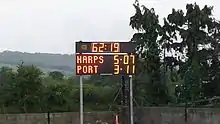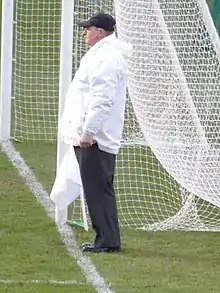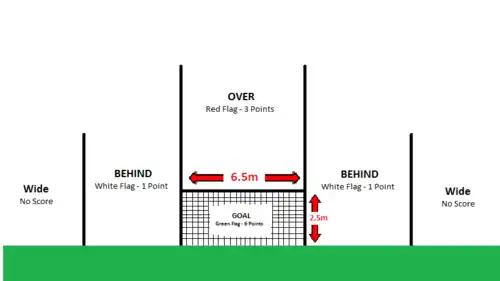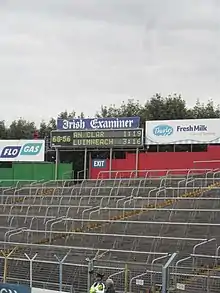Scoring in Gaelic games
This page discusses scoring in the Gaelic games of hurling, Gaelic football, camogie, ladies' Gaelic football, international rules football and shinty-hurling.

Note that although rounders and Gaelic handball are considered "Gaelic games", they are not listed under this page.
Scoring


In hurling, Gaelic football, camogie, ladies' Gaelic football and shinty-hurling, the goalposts are placed 6.5 m (21 ft) apart and are at least 7 m (23 ft) tall,[1] with a crossbar at a height of 2.5 m (8 ft 2 in). Playing the ball (a sliotar or Gaelic football, depending on the game) between the posts and below the crossbar scores a goal (Irish: cúl), while playing the ball between the posts and above the crossbar scores a point (cúilín). A goal is worth 3 points. The umpire signifies a goal by waving a green flag, and a point by waving a white flag. Signal flags have been used since the 1900s; one game in the United States in 1907 used a US flag to signify points, and an Irish flag (presumably the tricolour) for a goal.[2] The tradition of green flag for goal and white flag for point appears to date from the 1920s.[3][4][5]

In international rules football there are further posts 6.5 m (21 ft) either side of the goalposts. Playing the ball between the goalposts and these side posts scores a behind. Playing the ball between the centre posts and below the crossbar scores a goal, while playing the ball between the posts and above the crossbar scores an over. A goal is worth 6 points, an over 3, and a behind 1.
Terminology
The Irish term for goal is cúl, cognate with Latin cūlus, "rear." "Point" is cúilín, a diminutive form.
History
First GAA rules
The first Gaelic football and hurling rules were published by the fledgling Gaelic Athletic Association in 1885. These specified goalposts similar to soccer goals: for football 15 ft (4.6 m) wide and a crossbar 8 ft (2.4 m) high, while for hurling they were 20 ft (6.1 m) wide and a crossbar 10 ft (3.0 m) high. Goals were the only score possible; this led to a high number of scoreless draws.[6]
In 1886, two poles were placed 21 ft (6.4 m) either side of the goals.[7] A goal was scored when the ball was played into the goal; a point was scored when the ball was played above the crossbar, or wide of the goals between the two outer posts. When the ball was played wide of the outer posts, no score was recorded, unless it was played by a defender, in which case a forfeit point was awarded.[8][9]
Whichever team scored more goals won the game; if teams were tied on goals, points were counted, and forfeit points were worth 1⁄5 of a point. The score was written in the format goals–points (forfeit points), e.g. Tipperary's score of 1-1 (1) in the 1887 All-Ireland Senior Hurling Championship Final. Forfeit points rarely made any difference, although one game in 1887 ended North Tipperary 0-0 (1), Holycross 0-0 (0).[10]
Changes
| Period | Goal | Point | Forfeit point |
|---|---|---|---|
| 1885 | 1 | n/a | |
| 1886–87 | ∞ | 1 | 1⁄5 |
| 1888–91 | n/a | ||
| 1892–95 | 5 | ||
| 1896–present | 3 | ||
In 1888 the forfeit point was abolished, replaced by a 70 yd (64 m) puck in hurling and a 50 yd (46 m) kick in football. Hurling and Gaelic football goals were made the same size: 21 ft (6.4 m) by 8 ft (2.4 m).[11]
In 1892 the goal was changed to be worth five points.
In 1896 the goal was reduced to three points, and has held that value ever since.
In 1910 the side posts were removed, and the H-shaped goalposts introduced. Now, a point had to go over the crossbar.[12]
Modern experiments
In the 2005 National Hurling League two points were awarded for a point scored from a sideline cut in hurling, in recognition of the difficulty of this skill (typically only about one-fifth of such efforts are successful).[13][14]
The idea of increasing the value of the goal to 4 points has come up repeatedly in recent years.[15][16]
Frequency
_(2).jpg.webp)
An oft-repeated aphorism, especially with regard to Gaelic football, is "points win games" or "take your points and the goals will come."[17][18] This has become especially true in recent decades: in the mid-1970s, games in the All-Ireland Senior Football Championship averaged 3.5 goals, but in the 2000s this had fallen to 1 goal per game. Martin Breheny observed "Improved fitness levels, more mobile defenders, and better defensive techniques have combined to seal off attackers' approach routes, making the goal an endangered species." Raising the value to 4 or even 5 points has been suggested.[19]
In hurling, goals per game has decreased from a peak of 4.18 per game in 1983, in part because of a rule change that banned handpassed goals.[20][21]
Notation

A particular notation has been developed over the years by journalists and statisticians to record scoring in Gaelic games.
Score by team
A team's score is given in the form goals-points, separated by either a hyphen ( - ) or en dash ( – ), for example Kerry 2-10 Cork 1-12. The total points score may be given in brackets afterward for clarity: Kerry 2-10 (16) Cork 1-12 (15), but goals are never converted into points. Unlike other sports, where the home team's name is given before the away team, in Gaelic games the winning team's name is almost always given first.
Scores are spoken aloud thus:
- 0-20: "twenty points"
- 1-6: "one six"
- 3-17: "three seventeen"
- 2-0: "two goals"
- 0-0: "no score"
In international rules football, the score is given in the format goals.overs.points (total), for example the 2014 International Rules Series ended Australia 0.17.5 (56), Ireland 2.9.7 (46).
Score by player
In newspaper and other written accounts of games, the score of each individual player is given in abbreviated format. First the total is given, and then it is broken down by dead ball scores.
- f or fs: free kicks / free pucks
- pen: penalty kicks / penalty pucks
- '45' or ‘45: 45-metre kick (awarded in Gaelic football and ladies Gaelic football when a defender plays the ball over his/her own end line, like a corner kick in soccer); a 45-metre puck is awarded in camogie
- '65' or ‘65: 65-metre puck (awarded in hurling when a defender plays the ball over his own end line)
- s/l or sl: sideline kicks / sideline pucks
- Scores from open play are not indicated; any scores not accounted for by dead ball are from open play by default.
So if a report says James Kelly 2-5 (1-1f, 1-0pen, 0-2 '45'), it means that he scored 2 goals and 5 points, of which a goal and a point were from frees, a goal from a penalty, two points from 45-metre kicks, and the other two points were from open play. If no goals are scored, the 0- will be omitted, e.g. Michael O'Shea 0-9 (5f, 1 '65', 1 s/l). If all scores were of one type, the brackets may be omitted, reading: Síle Harrington 0-5f (indicating five points, all of which were frees) or J. J. Maguire 1-0pen (one goal, a penalty) or sometimes Sarah Moore 0-4(fs).[22]
References
- http://ww.w.thesmartjournal.com/GAA.pdf
- Wejnert, Barbara; Parigi, Paolo (21 December 2016). On the Cross Road of Polity, Political Elites and Mobilization. Emerald Group Publishing. ISBN 9781786354792 – via Google Books.
- "The Irish Digest". Irish Digest. December 22, 1945 – via Google Books.
- The Irish Times (Monday, August 20, 1923)
- The Irish Times (Monday, December 4, 1922), page 9.
- "LEAVING CERTIFICATE HISTORY CASE STUDY". webcache.googleusercontent.com.
- "Collections & Research | National Museum of Ireland".
- "Up Tipp: Hurling & Nationalism". 1 February 2017.
- https://crokepark.ie/BlankSite/media/Images/secondary-schools-resource-pack.pdf
- Rouse, Paul (6 September 2018). The Hurlers: The First All-Ireland Championship and the Making of Modern Hurling. Penguin UK. ISBN 9781844884407 – via Google Books.
- Chadwick, H. (7 November 1893). The reliable book of outdoor games. Рипол Классик. ISBN 9785872410195 – via Google Books.
- Stafford, Mikey (15 July 2018). "The Game - 7 Ages of Hurling".
- "Ladies sticking with skirts as O'Flynn backs rules makeover - Independent.ie".
- "Cutting edge: Line art still a major draw - Independent.ie".
- Neville, Conor. "Every Known Solution To Improve The GAA In The Past 20 Years".
- "Hurling Review Committee". www.gaa.ie.
- "Cork GAA Official Website". gaacork.ie.
- "Take the points and the goals..." 6 June 2015.
- "Time for the GAA to re-assess its football goals - Independent.ie".
- O'Connor, Christy (6 August 2018). "The art of the 'assassin' & the lust for green flags".
- "Is point scoring really increasing in Championship Hurling?". 6 July 2011.
- "FL2: Rossies rally stuns Premier - HoganStand". www.hoganstand.com.